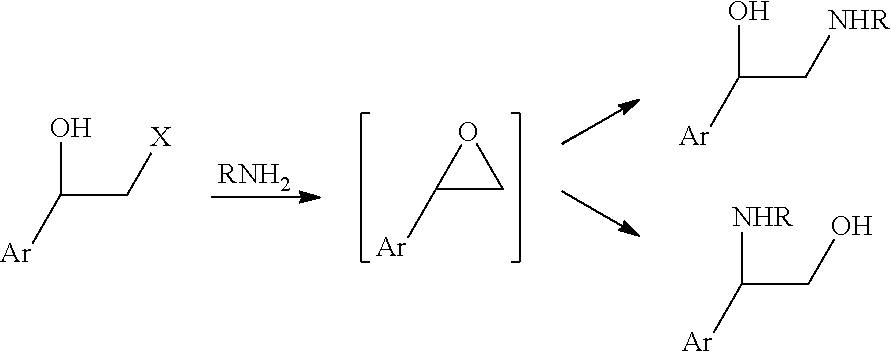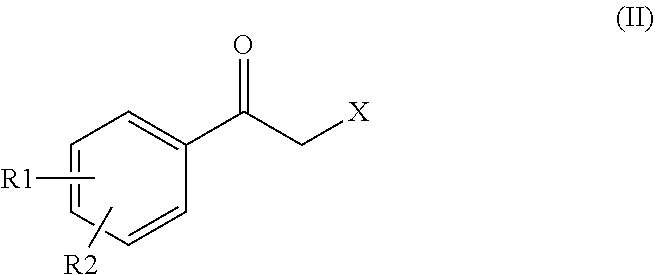Process for preparing intermediates for the synthesis of optically active beta-amino alcohols by enzymatic reduction and novel synthesis intermediates
a technology of beta-amino alcohol and intermediates, which is applied in the field of chiral phenylbetaamino alcohols, can solve the problems of high cost of metal catalysts, high yield, and inconvenient synthesis path of synthesis paths, and achieve high enantiomeric excesses and good yields
- Summary
- Abstract
- Description
- Claims
- Application Information
AI Technical Summary
Benefits of technology
Problems solved by technology
Method used
Image
Examples
preparation 1
Preparation of the Enzymatic Solution
[0121]Competent Escherichia coli cells Starb121 (DE3) (Invitrogen) have been transformed with the construct pET21a-MIX encoding for the oxidoreductases. The colonies of cells transformed with the constructs have been cultured in 200 ml LB medium (1% tryptone, 0.5% yeast extract and 1% NaCl) with 50 μg / ml ampicillin or 40 μg / ml kanamycin, respectively, until an optical density of 0.5 measured at 550 nm is achieved. The expression of the recombinant protein has been induced by adding isopropyl-thiogalactoside (IPTG) with a concentration of 0.1 mM. After 16 hours of induction at 25° C. and 220 revolutions / minute, the cells have been collected and frozen at −20° C. For the preparation of the enzymatic solutions, 30 g cells have been re-suspended in 150 ml triethanolamine buffer (100 mM, pH 7, 2 mM MgCl2, 10% glycerol) and homogenized by using a high pressure homogenizer. Subsequently, the enzymatic solution has been mixed with 150 ml glycerol and sto...
example 1
Preparation of a Compound of Formula (II) and (II″)
[0122]
[0123]Hal=halogen, preferably bromine or chlorine
[0124]5 g compound A (wherein Hal=Cl) is dissolved in 50 ml DMF. 3.5 g succinimide potassium salt has been added to the solution. Upon complete reaction, 50 ml water and 100 ml DCM have been added. The organic phase has been dried over sodium sulphate, filtered and concentrated to a residue. 60 ml heptane and 10 ml DCM have been added, then the bulk was filtered, collecting 4.7 g of compound B that, in the dried form, provided 4.5 g of compound B, with HPLC purity higher than 99%.
example 2
[0125]
[0126]1 g of compound B has been dissolved in 3 ml 2-propanol and 4 ml MTBE. 13 ml aqueous potassium buffer at pH 8, 1 mg NAD and 5 ml enzyme SEQ ID No: 1 (OX 56) have been added. The bulk has been stirred at about 35° C. until complete conversion of ketone to alcohol. The separated aqueous phase has been extracted twice with DCM, then the organic phases have been combined and concentrated to a solid. Yield 900 mg, HPLC purity>96%, S-alcohol not detectable (chiral HPLC analysis).
[0127]By operating as described in Example 2, the reactions on compound B and the following compounds have been carried out in the conditions and with the results reported in Table (I):
[0128]
CompoundEnzymeCofactor Solventee (S)ee (R)BSEQ ID No.: 1 NADMPnd>99.9%(ox56)DSEQ ID No.: 1 NADIPAnd 100%(ox56)ESEQ ID No.: 1 NADIPA0.6% 99.4%(ox56)ESEQ ID No.: 1NADMP0.7% 99.3%(ox56)FSEQ ID No.: 2NADIPA2.4% 97.6%(ox62)FSEQ ID No.: 2NADMP2.0% 98.0%(ox62)GSEQ ID No.: 1NADMPnd 100%(ox56)GSEQ ID No.: 1NADIPAnd ...
PUM
| Property | Measurement | Unit |
|---|---|---|
| enantiomeric excess | aaaaa | aaaaa |
| enantiomeric excess | aaaaa | aaaaa |
| enantiomeric excess | aaaaa | aaaaa |
Abstract
Description
Claims
Application Information
 Login to View More
Login to View More - R&D
- Intellectual Property
- Life Sciences
- Materials
- Tech Scout
- Unparalleled Data Quality
- Higher Quality Content
- 60% Fewer Hallucinations
Browse by: Latest US Patents, China's latest patents, Technical Efficacy Thesaurus, Application Domain, Technology Topic, Popular Technical Reports.
© 2025 PatSnap. All rights reserved.Legal|Privacy policy|Modern Slavery Act Transparency Statement|Sitemap|About US| Contact US: help@patsnap.com



